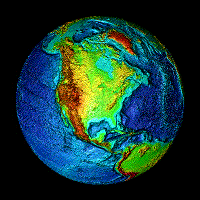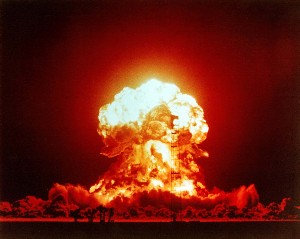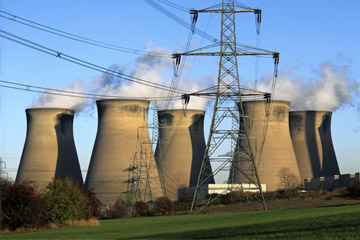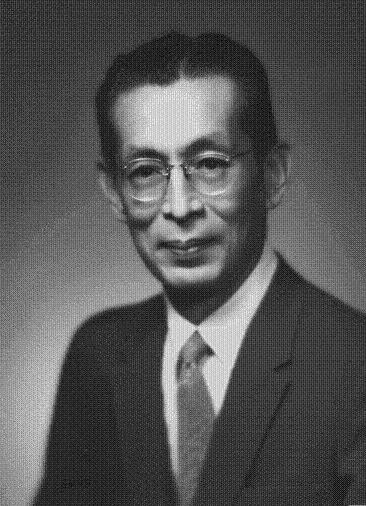 
P. K. Kuroda: Feasibility of Natural Nuclear
Reactors in Uranium Mines |
|
  Early
in 1939, Otto Hahn and Fritz Strassmann published in Die Naturwissenschaften
their discovery of nuclear fission, the splitting of the nucleus of uranium
atoms. Later in the same year and in the same journal, Siegfried Flügge
speculated on the possibility of nuclear fission chain reactions occurring in nature.
But as the clouds of World War II darkened over Europe and the rest of the
world, interest in nuclear fission focused upon the design and production of
nuclear fission devices (atom bombs). After the war, attention focused upon
commercial nuclear electric power production and nuclear submarine propulsion.
Little attention was directed to nuclear fission in nature, very little
attention was paid to the possibility of nuclear fission in nature. Early
in 1939, Otto Hahn and Fritz Strassmann published in Die Naturwissenschaften
their discovery of nuclear fission, the splitting of the nucleus of uranium
atoms. Later in the same year and in the same journal, Siegfried Flügge
speculated on the possibility of nuclear fission chain reactions occurring in nature.
But as the clouds of World War II darkened over Europe and the rest of the
world, interest in nuclear fission focused upon the design and production of
nuclear fission devices (atom bombs). After the war, attention focused upon
commercial nuclear electric power production and nuclear submarine propulsion.
Little attention was directed to nuclear fission in nature, very little
attention was paid to the possibility of nuclear fission in nature.
|
|
  Think about a nuclear reactor and the image that may come to mind is of extreme
complexity, the seemingly exotic blue glow surrounding the core of some types of
reactors or perhaps the image of a nuclear reactor control room with as many
gauges and controls as the cockpit of a 747 jetliner.
But, stripped of man-made control apparatus, a nuclear reactor is surprisingly
simple,
just a mass of uranium with two important properties. The mass must be
sufficiently large so that not too many neutrons escape and the
fissionable uranium must be sufficiently pure so that not too many
neutrons are used for non-fission activities. The readily fissionable
component of uranium, U-235, comprises less than one percent of
naturally occurring uranium; most is U-238. The low abundance of U-235
in natural uranium makes natural nuclear reactors virtually impossible
to begin operating today, which is the main reason that little interest
was paid to the possibility of natural nuclear reactors. Think about a nuclear reactor and the image that may come to mind is of extreme
complexity, the seemingly exotic blue glow surrounding the core of some types of
reactors or perhaps the image of a nuclear reactor control room with as many
gauges and controls as the cockpit of a 747 jetliner.
But, stripped of man-made control apparatus, a nuclear reactor is surprisingly
simple,
just a mass of uranium with two important properties. The mass must be
sufficiently large so that not too many neutrons escape and the
fissionable uranium must be sufficiently pure so that not too many
neutrons are used for non-fission activities. The readily fissionable
component of uranium, U-235, comprises less than one percent of
naturally occurring uranium; most is U-238. The low abundance of U-235
in natural uranium makes natural nuclear reactors virtually impossible
to begin operating today, which is the main reason that little interest
was paid to the possibility of natural nuclear reactors.
|
|
 But then along
came Paul Kazuo Kuroda, who realized that because U-235 has a considerably
shorter half-life than U-238, the relative abundance of U-235 would have been
greater in times past. In
1956, Paul K. Kuroda, pictured at left, published a short paper in the Journal of Chemical
Physics demonstrating the feasibility that thick seams of uranium ore about
one meter thick might,
2,000 million years ago, have been able to support nuclear fission chain reactions and function
as natural nuclear reactors (click here for pdf).
For 16 years the idea languished in obscurity, ignored by geo-scientists, until
proof came dramatically and unexpectedly by the discovery of fossil natural
nuclear reactors in a uranium mine at Oklo, near Franceville, in the Republic of
Gabon. There is much, much more to this story and to the consequences. But then along
came Paul Kazuo Kuroda, who realized that because U-235 has a considerably
shorter half-life than U-238, the relative abundance of U-235 would have been
greater in times past. In
1956, Paul K. Kuroda, pictured at left, published a short paper in the Journal of Chemical
Physics demonstrating the feasibility that thick seams of uranium ore about
one meter thick might,
2,000 million years ago, have been able to support nuclear fission chain reactions and function
as natural nuclear reactors (click here for pdf).
For 16 years the idea languished in obscurity, ignored by geo-scientists, until
proof came dramatically and unexpectedly by the discovery of fossil natural
nuclear reactors in a uranium mine at Oklo, near Franceville, in the Republic of
Gabon. There is much, much more to this story and to the consequences.
Return to Home Page
NuclearPlanet.com
|
|

